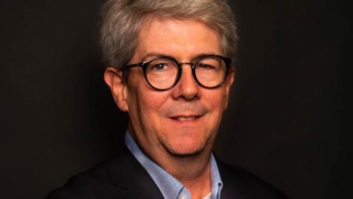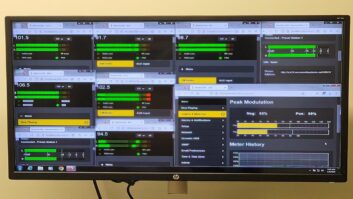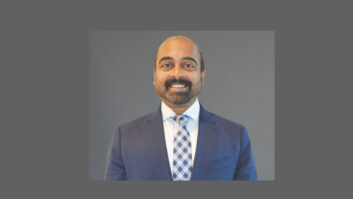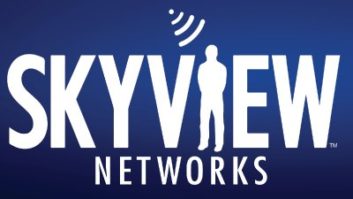The images in this archived story are no longer available.
Educational Media Foundation is based in Rocklin, Calif., and owns and operates the radio networks of Air1 and K-LOVE.
EMF began operating its first station in 1982 and moved to Sacramento, Calif., in 1993, after a single station grew to 14 (seven stations and seven translators). In 2002, EMF moved to its current location, which includes a group of 77 engineering personnel in various roles, such as field engineers, technicians, NOC operators, site development, software and engineering operations. The Rocklin-based department focuses on network distribution and RF for 800+ signals across the country.

EMF’s philosophy has been to maintain a very cost-effective infrastructure, but early on, the organization made the decision to use only the best equipment appropriate for a station’s budget, without neglecting on-air sound and reliability.
In the early 2000s, EMF started to build turnkey facilities using the same equipment and layout at every site, to the extent possible. This decision made it easier to have repair and replacement gear on hand, as well as ensuring that the depth of knowledge at their home-base was sufficient to remotely talk contract engineers through any problem.
THE SECRET STUDIO
EMF’s current facility in Rocklin began with 23 studios made up of nine production rooms, six voice-tracking rooms, four news studios, four on-air studios (two main and two redundant backups) and a secret voice-tracking studio inside the president’s office!
The facility was wired around a three-tier TDM router that utilized fiber, AES-3 (110 ohm cable) and 75-ohm cable. The copper infrastructure made for a perfect marriage with the PR&E Hybrid Consoles that they have been running to date.
THE NEW DESIGN
The studio facility is being redesigned in a collaborative effort between the PD, studio ops, engineering, in-house API developers and other partners, such as the Telos Alliance, RCS, Pico Digital and GatesAir.
The goal was to open up the studios and to create a visual radio concept ready for HD video, while at the same time becoming more conductive for talk.
EMF continued with its tradition of standup furniture, but also added a kitchen-height solid surface, counter top allowing the co-host the option to sit. The studio furniture also includes an ADA-compliant wheelchair position. The transition from 39-inch to kitchen height to wheelchair position creates a tri-level aesthetic that transitions to sitting position in a less dramatic form.
Each design was carefully considered with respect to color, aesthetics and ergonomics. EMF has an in-house tech who is also a craftsman that made life-size 1:1 cardboard models of all the furniture in the CAD Drawings to ensure everything felt right in the room before the sign- off of the blueprints.
UPCOMING TRANSITION
EMF has recently brought up their new Axia System, comprising Axia Fusion and Element consoles with a la carte modules based on the needs of each studio. Every source and destination gets a unique ID that is managed by Axia’s Pathfinder software. The heart of this system is the Excel spreadsheet that keeps all those unique IDs organized.
EMF prefers being a “centralized network,” not only in the distribution of programming, but in the use of equipment at all of their stations. Engineering is inclined to modify equipment as necessary to fit the organization’s unique needs.
In 2009, both the Air1 and K-LOVE Morning Shows moved to Eastern Time with the acquisition of a three-studio facility in Indianapolis. That facility utilizes a Harris Vistamax Router with Harris control surfaces with built-in nodes. There are many custom-built hardware pieces to control the switch between the two facilities, including those that route relay commands and RDS. This process is handled by the board operators in Rocklin.
Choosing to build an infrastructure that is not too proprietary, but that remains customizable for their needs is the challenge EMF engineering is facing. The building of the parallel infrastructure and maintenance the existing on-air system is not an easy set of tasks.
EMF is also building a Cisco infrastructure with passive redundant back-planes and extra switches in an arrangement configured to be self-healing. Allowing the Axia Pathfinder software to act as the router and control management will facilitate the plan to allow any of the 23 studios to become an on-air room as long as local RCS Zetta machine has Axia drivers and unique IDs configured.
NETWORK DISTRIBUTION FEATURES
Two of the newsrooms in Rocklin were customized to give access to two uplink channels that were routable by the staff using an EMF-developed application they call SUI (satellite user interface). The backup redundant studios became break-out rooms and were assigned additional uplink channels that (via SUI) can go live and break the network feed in any of EMF’s markets. The key pieces of this function were the SUI in combination with the Wheatstone bridge.
EMF uses a customized store-and-forward system to automate the file transfers to players in the field for localized content. This system was built by Wegener in collaboration with EMF. The automation system sends pulses (scheduled in the log) to all the sites and the players all play the stored content. This feature also allows EMF to send a local event to a specific destination without being distributed across the whole network.
Over the course of the next couple years this will be replaced with a new system, based instead on AoIP combined with the RCS automation system.
EMF plans to virtualize everything to have the flexibility that comes with modern networking within the context of broadcast. Whereas now EMF uses Wegener iPump satellite receivers with a hard drive to play local content when a relay is triggered, the new system will feature “relays” that are ingested as pad data in to a centralized mux that marries data with Livewire, subsequently virtualized, and then sent to the remote sites via UDP. This system will be a custom design from the EMF Engineering team in collaboration with Pico Digital.
Indianapolis will connect assets via MPLS and RCS’s Site Replication, which was originally developed for Sirius XM. Distribution of the audio feed will be handled by EMF’s satellite team using the infrastructure of that site.
From its headquarters in Rocklin, audio will be routed to remote sites via multiple solutions including AoIP over private networks, satellite and even ISDN, depending on location and function.
RF FACILITY / TX REBUILDS
EMF built much of its network on older, high-quality transmitters, and they learned early on that there could be significant cost advantages if they purchased used transmitters. The investment a few thousand dollars’ worth of repair parts and the appropriate number of man-hours for cleaning could provide a transmitter that is just about as good and reliable as new.
Unfortunately, the economic decline of 2008-2009 meant that many broadcasters stopped replacing their transmitters, and so the used transmitter market dried up to a small trickle.
Today, EMF is mostly buying new transmitters and the “Transmitter Lab” focuses on low-power (exciter, translator) repairs and re-builds. The organization hopes to start up the rebuilding full-size transmitters sometime in the not-too-distant future.
From their means of distribution, to their emphasis on consistency in their transmission facilities, the engineering department of EMF has developed an efficient, innovative network —one worthy of note and emulation.
VP of Engineering Sam Wallington, Director of Engineering David Shantz and Manager of Studio Operations Jonathan Obien contributed to this article.












